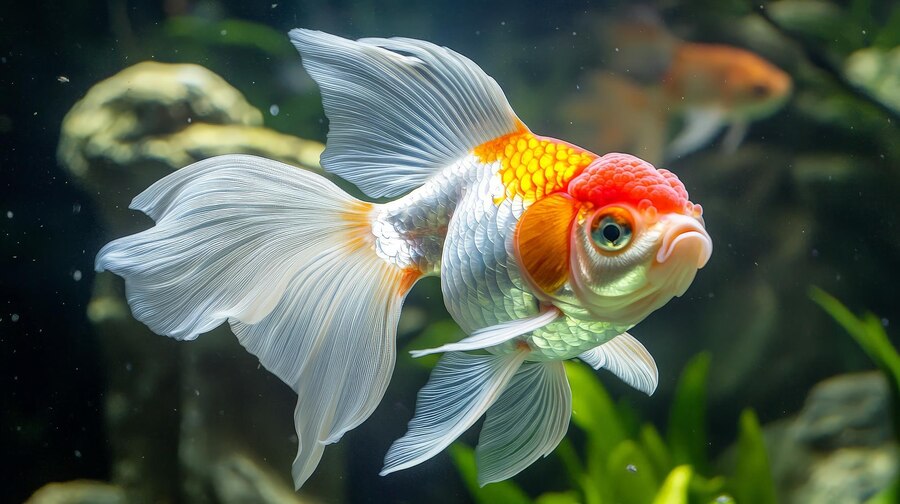Goldfish have long been cherished as pets due to their vibrant colors, playful nature, and relatively low maintenance needs. Among the myriad of goldfish types, the Oranda stands out with its distinctive features and captivating beauty. In this comprehensive guide, we will delve into the fascinating world of Oranda goldfish, exploring their characteristics, care requirements, and tips for keeping them healthy and thriving in your aquarium.
Understanding the Oranda Goldfish
The Oranda goldfish is a domesticated variant of the common goldfish, scientifically known as Carassius auratus. They are recognized for their rounded bodies and distinctive hood-like growths on their heads, known as “wen.” This unique feature adds a touch of elegance to their appearance, making them popular among fish enthusiasts and hobbyists.
Physical Characteristics
Oranda goldfish exhibit a variety of colors and patterns, including red, orange, white, and calico. Their bodies are typically round and robust, with long, flowing fins that enhance their graceful swimming style. The wen, which develops as they mature, can vary in size and shape, ranging from small bumps to large, fluffy crowns.
These fish can grow to a size of 8 to 12 inches (20 to 30 cm) in length, making them suitable for larger aquariums or outdoor ponds. Their vibrant colors and unique shapes make them a stunning addition to any aquatic environment.
Varieties of Oranda Goldfish
Oranda goldfish come in several varieties, each showcasing distinct characteristics. The most common varieties include:
- Red Oranda: Known for their bright red coloration, these Orandas are a favorite among hobbyists.
- Calico Oranda: These goldfish feature a stunning mix of colors, including blue, white, and orange, creating a mesmerizing pattern.
- White Oranda: This variety is characterized by its pure white body and striking red or orange wen.
- Black Oranda: This unique variety has a deep black coloration, making it stand out in any aquarium.
Each variety has its own unique beauty, contributing to the overall appeal of the Oranda goldfish.
Care Requirements for Oranda Goldfish
Caring for Oranda goldfish requires understanding their specific needs to ensure they live healthy and fulfilling lives. Here are some essential care tips:
Aquarium Setup
The right aquarium setup is crucial for the well-being of Oranda goldfish. Here are some key considerations:
- Tank Size: A minimum tank size of 20 gallons is recommended for a single Oranda goldfish. If you plan to keep multiple Orandas, increase the tank size accordingly.
- Water Quality: Orandas are sensitive to water conditions. Maintain a temperature range of 65°F to 75°F (18°C to 24°C) and a pH level between 6.5 and 8.5. Regular water changes (about 25% weekly) are essential to keep the water clean and safe.
- Filtration: A good filtration system is necessary to keep the water clean and well-oxygenated. Choose a filter that can handle the tank’s size and ensure it is rated for goldfish, as they produce a lot of waste.
- Substrate and Decor: Use a fine substrate to prevent injury to their delicate fins. Add plants, rocks, and ornaments to create hiding spots and enrich their environment. However, avoid sharp edges that could harm the fish.
Diet and Nutrition
Providing a balanced diet is vital for the health and growth of Oranda goldfish. Here’s how to ensure they receive proper nutrition:
- High-Quality Pellets: Choose a high-quality goldfish pellet that contains a balanced mix of proteins, fats, and carbohydrates. These pellets should be specifically formulated for goldfish to promote healthy growth.
- Variety in Diet: Supplement their diet with fresh vegetables (like blanched spinach, peas, or zucchini), frozen or live foods (such as brine shrimp or bloodworms), and high-quality flakes. Variety in their diet helps provide essential nutrients.
- Feeding Schedule: Feed your Orandas small amounts of food two to three times a day. Ensure they consume the food within a few minutes to prevent overfeeding and maintain water quality.
Health and Maintenance
Maintaining the health of your Oranda goldfish involves regular monitoring and care:
- Regular Check-ups: Observe your goldfish for signs of illness, such as changes in behavior, swimming patterns, or physical appearance. Early detection is crucial for successful treatment.
- Water Testing: Regularly test the water parameters, including ammonia, nitrite, nitrate, pH, and hardness. Keeping the water conditions stable is essential for their health.
- Treating Illness: If your Oranda shows signs of illness, such as frayed fins, discoloration, or lethargy, isolate them from the main tank and consult an aquatic veterinarian for appropriate treatment.
Socialization and Tankmates
Oranda goldfish are generally peaceful and can coexist with other compatible species. Here are some tips for selecting tankmates:
- Compatible Species: Choose other peaceful goldfish varieties or non-aggressive fish that thrive in similar water conditions. Avoid aggressive or fin-nipping species, as they can stress your Oranda.
- Avoid Overcrowding: Be mindful of tank size and avoid overcrowding, which can lead to stress and health issues.
- Observation: Monitor interactions between your Oranda and its tankmates to ensure compatibility. If you notice aggressive behavior, be prepared to separate the fish.
Breeding Oranda Goldfish
Breeding Oranda goldfish can be a rewarding experience for enthusiasts. Here are the steps involved in breeding them:
Breeding Setup
To breed Oranda goldfish successfully, you need to set up a separate breeding tank:
- Breeding Tank: A 30-gallon breeding tank is ideal for breeding Orandas. Provide ample hiding spots and plants to encourage spawning.
- Water Conditions: Maintain slightly cooler water temperatures (around 65°F to 70°F or 18°C to 21°C) to stimulate breeding behavior.
Spawning Process
The spawning process typically occurs in the spring when water temperatures begin to rise:
- Selecting Breeders: Choose healthy male and female Orandas for breeding. The males will display more vibrant colors and chase the females during breeding.
- Spawning Behavior: Males will chase females, and once the female is ready, she will lay eggs on the tank’s surface. The males will fertilize the eggs shortly after.
- Egg Care: Remove the adults after spawning to prevent them from eating the eggs. The eggs will hatch in 4 to 7 days, depending on water temperature.
Raising Fry
Once the eggs hatch, the fry will require special care:
- Fry Food: Initially, feed the fry infusoria or powdered fry food. As they grow, gradually introduce finely crushed flakes or brine shrimp.
- Tank Maintenance: Maintain excellent water quality, as fry are sensitive to pollutants. Perform regular water changes to keep their environment clean.
Common Issues and Troubleshooting
Even with proper care, Oranda goldfish can face several issues. Here are some common problems and their solutions:
Swim Bladder Disorder
Swim bladder disorder is a common issue among goldfish, causing buoyancy problems:
- Symptoms: Affected Orandas may float at the surface or sink to the bottom.
- Solutions: Ensure a balanced diet, avoid overfeeding, and consider fasting the fish for a day or two. If the problem persists, consult a veterinarian.
Fin Rot
Fin rot is a bacterial infection that can affect goldfish:
- Symptoms: Frayed or discolored fins may indicate fin rot.
- Solutions: Improve water quality, perform water changes, and treat the fish with appropriate antibacterial medication.
Ich (White Spot Disease)
Ich is a parasitic infection that can affect goldfish:
- Symptoms: Small white spots on the body and fins, along with rubbing against objects.
- Solutions: Increase the water temperature gradually and treat with anti-ich medication. Ensure proper quarantine for new fish before adding them to the tank.
Conclusion
Oranda goldfish are a captivating and unique addition to any aquarium. Their beautiful appearance, gentle nature, and relatively straightforward care requirements make them an ideal choice for both beginners and experienced fish enthusiasts. By providing the right environment, nutrition, and care, you can ensure that your Oranda goldfish thrive and bring joy to your aquatic setup for years to come.
FAQs
What size tank do Oranda goldfish need?
Oranda goldfish require a minimum tank size of 20 gallons. Larger tanks are recommended if keeping multiple Orandas.
How often should I feed my Oranda goldfish?
Feed your Oranda goldfish small amounts of food two to three times a day, ensuring they consume it within a few minutes.
Can Oranda goldfish live with other fish?
Yes, Oranda goldfish can live with other peaceful species that thrive in similar water conditions. Avoid aggressive or fin-nipping fish.
How can I tell if my Oranda is sick?
Signs of illness in Oranda goldfish include changes in behavior, swimming patterns, discoloration, or frayed fins. Monitor your fish regularly for any unusual symptoms.
What should I do if my Oranda goldfish is floating?
If your Oranda is floating, it may have swim bladder disorder. Fast the fish for a couple of days and ensure it is not overfed. If the problem persists, consult a veterinarian.







